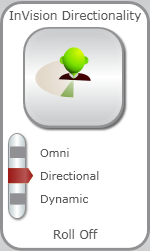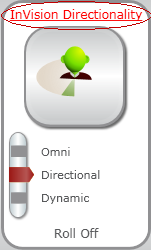
The term, InVision Directionality, refers to the directional technology utilized in the Advance 22 product line. InVision Directionality is designed to help improve speech understanding in noisy situations through directional microphone technology. It is standard on RICs and is also an available option for some of the custom products that fall into the categories of Full Shell (ITE) through Canal (ITC) products. The directional icon is present on many of the adjustment screens for products that are set to full time directional.
![]()
The directional settings are adjustable through the Features screen. There are four adjustable parameters for directional products: directional setting, switching threshold, time constants, and low frequency roll off.

There are three choices of settings for directionality: omni-directional, fixed directional and dynamic. When set to omni, the hearing instrument will maintain an omni-directional mode. When set to directional, the hearing instrument will maintain a full-time directional setting. When set to dynamic, the appropriate microphone mode is automatically determined. The hearing instrument will continually monitor the environment and gradually adjust to the appropriate mode (omni-directional or directional) to optimize speech intelligibility. The hearing instrument defaults to the dynamic setting for the Normal memory.
Switching threshold and time constants can be accessed by clicking on the words InVision Directionality  . The switching control provides 9 choices in 1 dB increments to change the directional activation threshold. Directional time constants default to medium. They can be adjusted to slower or faster time constants. Any changes to the directional time constants apply to all memories.
. The switching control provides 9 choices in 1 dB increments to change the directional activation threshold. Directional time constants default to medium. They can be adjusted to slower or faster time constants. Any changes to the directional time constants apply to all memories.
Roll off adjustments control the frequency response in the low frequencies, when the instrument is in directional mode. The three choices of Roll Off settings are: Off (where the directional frequency response matches the omni-directional response), Partial (6 dB/ octave), and Full (12 dB/ octave). The Roll Off is set during a Best Fit and is based on the 500 Hz threshold. Directional memories are set to Full when the 500 Hz threshold is between 0 and 40 dB. The Partial setting is used when the patient’s threshold at 500 Hz is between 40 and 70 dB. The Roll Off is set to Off, in the case where the 500 Hz threshold is greater than 70 dB. Roll off can be set in each memory independently.